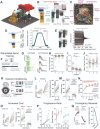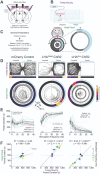This is a preprint.
An Open-Source Platform for Head-Fixed Operant and Consummatory Behavior
- PMID: 36712040
- PMCID: PMC9882199
- DOI: 10.1101/2023.01.13.523828
An Open-Source Platform for Head-Fixed Operant and Consummatory Behavior
Update in
-
An open-source platform for head-fixed operant and consummatory behavior.Elife. 2023 Aug 9;12:e86183. doi: 10.7554/eLife.86183. Elife. 2023. PMID: 37555578 Free PMC article.
Abstract
Head-fixed behavioral experiments in rodents permit unparalleled experimental control, precise measurement of behavior, and concurrent modulation and measurement of neural activity. Here we present OHRBETS (Open-Source Head-fixed Rodent Behavioral Experimental Training System; pronounced 'Orbitz'), a low-cost, open-source ecosystem of hardware and software to flexibly pursue the neural basis of a variety of motivated behaviors. Head-fixed mice tested with OHRBETS displayed operant conditioning for caloric reward that replicates core behavioral phenotypes observed during freely moving conditions. OHRBETS also permits for optogenetic intracranial self-stimulation under positive or negative operant conditioning procedures and real-time place preference behavior, like that observed in freely moving assays. In a multi-spout brief-access consumption task, mice displayed licking as a function of concentration of sucrose, quinine, and sodium chloride, with licking modulated by homeostatic or circadian influences. Finally, to highlight the functionality of OHRBETS, we measured mesolimbic dopamine signals during the multi-spout brief-access task that display strong correlations with relative solution value and magnitude of consumption. All designs, programs, and instructions are provided freely online. This customizable ecosystem enables replicable operant and consummatory behaviors and can be incorporated with methods to perturb and record neural dynamics in vivo .
Impact statement: A customizable open-source hardware and software ecosystem for conducting diverse head-fixed behavioral experiments in mice.
Figures







References
-
- Backyard Brains. (2013). Searcher- 3-D Printable Micromanipulator. https://backyardbrains.com/products/micromanipulator
Publication types
Grants and funding
LinkOut - more resources
Full Text Sources
